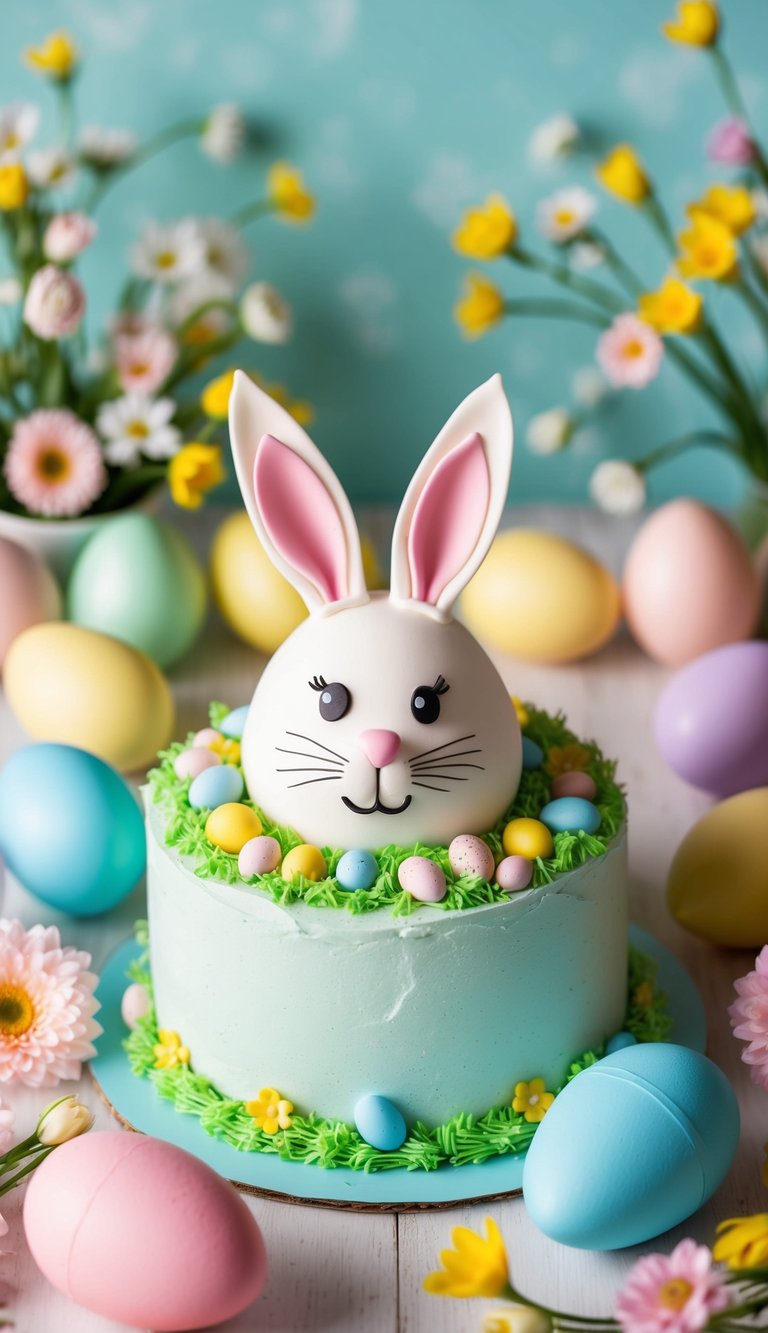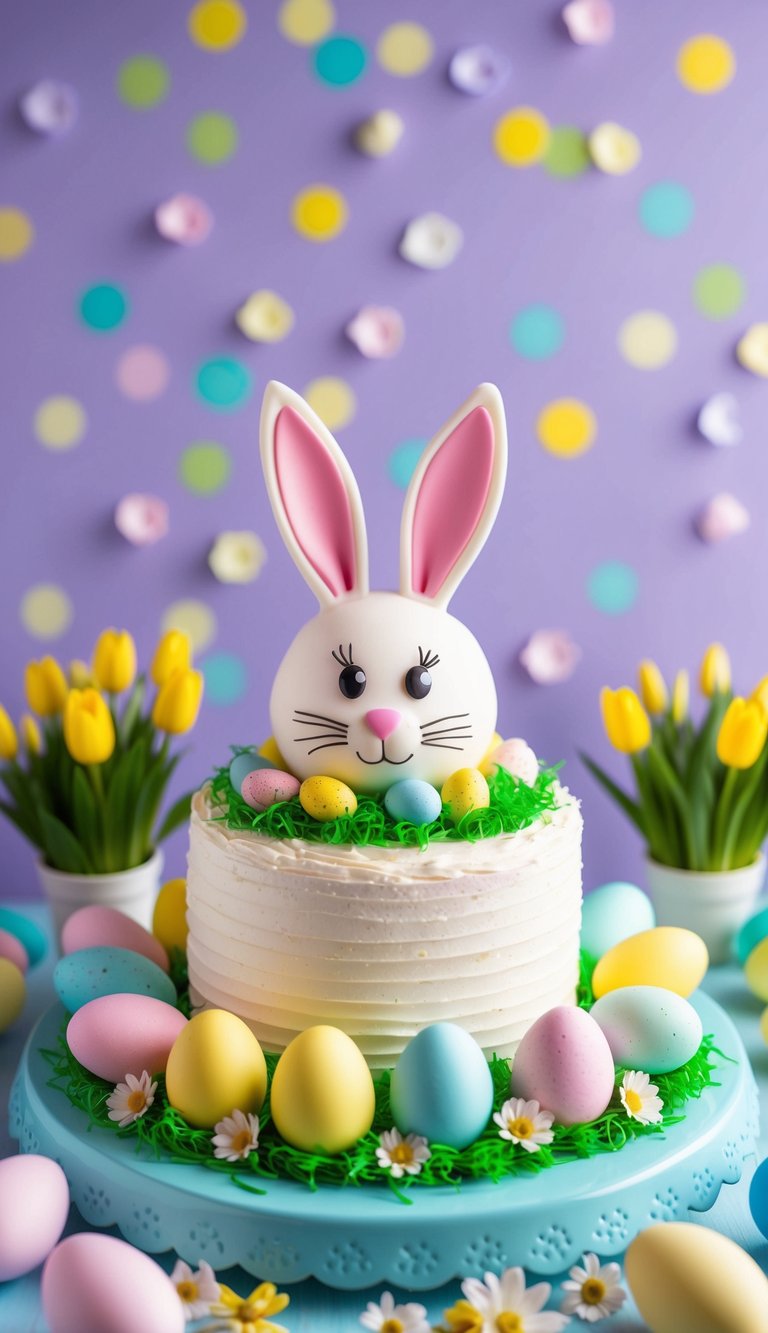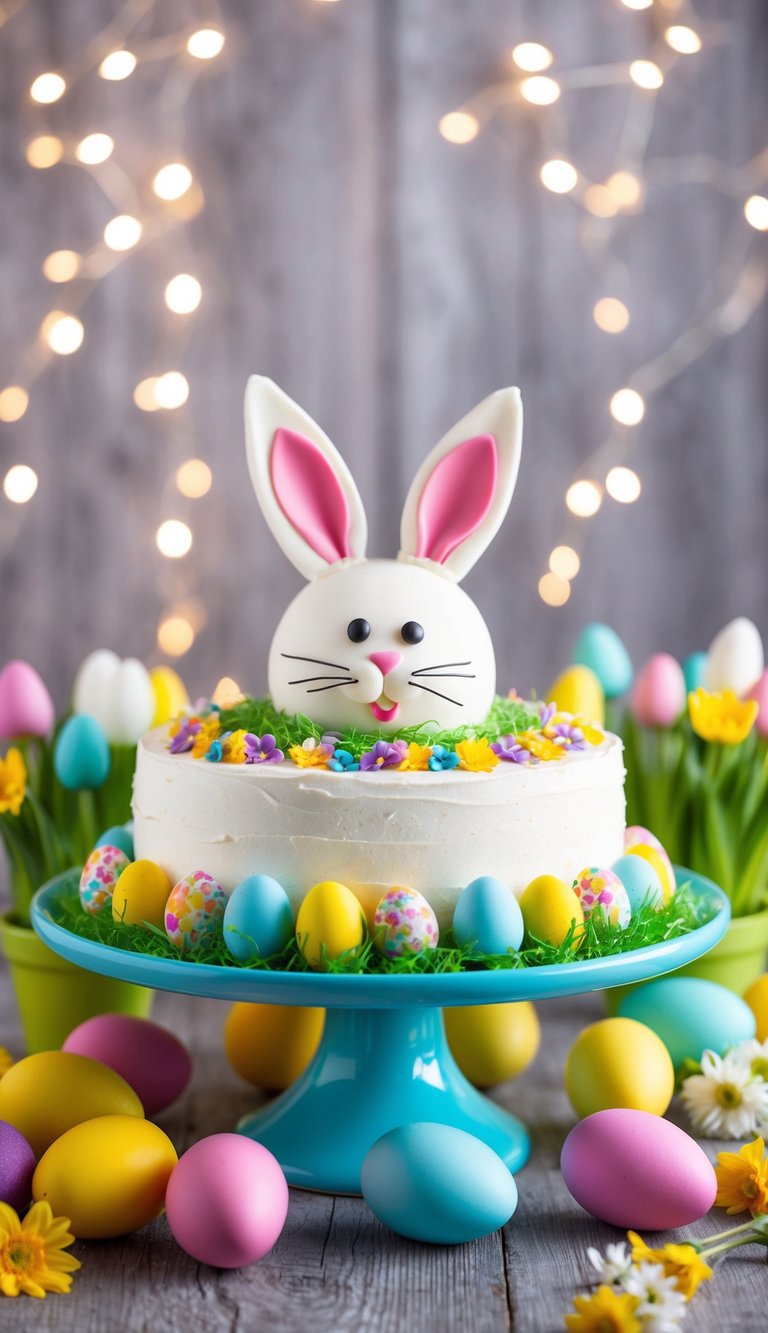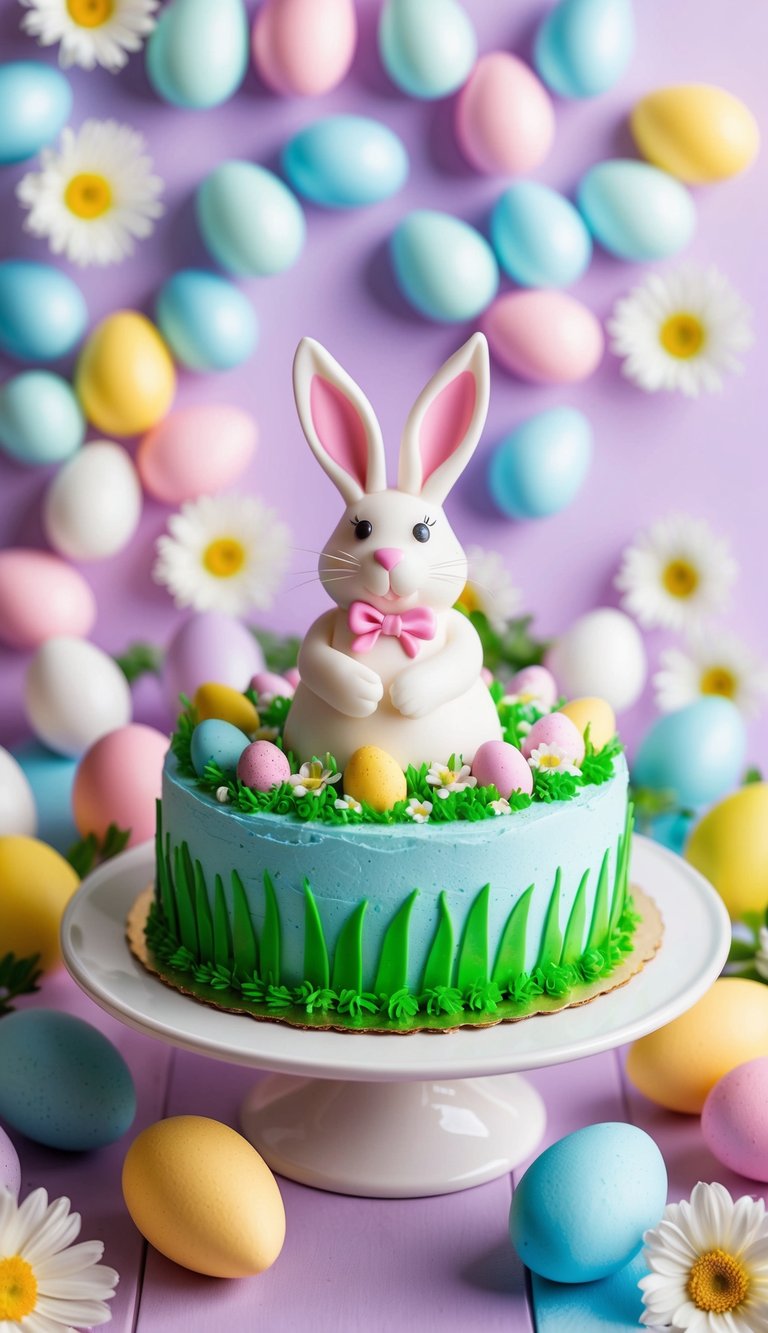The Easter Bunny Cake is a delightful treat that brings joy to any holiday gathering. This adorable cake not only serves as a tasty dessert but also adds a fun and festive touch to your Easter celebrations.
With its cute bunny design and colorful decorations, the Easter Bunny Cake becomes the centerpiece of the dessert table. Recipes like the ones from Food & Wine and Allrecipes provide step-by-step instructions that make the process simple.
As you prepare to create your own Easter Bunny Cake, you’ll discover how easy it is to infuse creativity and flavor into your baking.
From using box mixes to decorating with candy, this cake promises to be both fun and delicious, making it a holiday staple in many homes.
History of the Easter Bunny Cake

The Easter Bunny Cake has its roots in various cultural traditions that celebrate spring and renewal.
This cake combines baking artistry with family gatherings, creating lasting memories across generations.
I find these aspects fascinating, as they highlight how food can bring people together.
Cultural Significance
The Easter Bunny Cake holds a special place in many families, especially in the United States. This tradition often symbolizes fertility and the arrival of spring.
The cake is typically shaped like a bunny and decorated with colorful elements like icing and candy.
In addition to being a delightful treat, it represents fun and joy during the Easter holiday. Families often work together to make the cake, strengthening bonds through this shared activity.
Many people look forward to unveiling the Easter Bunny Cake at their celebrations, making it a focal point of the holiday feast.
Evolution Over Time
The Easter Bunny Cake’s evolution can be traced back to the late 1970s. It became popular in homes after being featured in magazines and cookbooks. I remember my mom discovering recipes that inspired her creations.
Baker’s Coconut introduced the idea of decorating the cake with shredded coconut and jelly beans, which became iconic. This style set a trend that many families now follow.
As time went on, variations of the cake emerged. Different regions added local flavors and styles, expanding its appeal.
The Easter Bunny Cake has transformed into a canvas for creativity, with bakers customizing shapes and decorations to reflect their tastes.
Essential Ingredients

Selecting the right ingredients is crucial for achieving the best flavor and texture when making an Easter bunny cake. I will discuss key components like flour, sweeteners, and dairy products, which directly impact the outcome of your cake.
Flour Options
Choosing the right flour is essential for the cake’s structure. Most recipes suggest either all-purpose flour or cake flour.
- All-Purpose Flour: Works well for a sturdy cake and provides a great balance.
- Cake Flour: Offers a softer texture and makes the cake tender.
If you want to experiment, I can also use whole wheat flour for added nutrition. However, whole wheat may alter the texture slightly.
Types of Sweeteners
Sweeteners play a key role in flavor and moisture. Common options include:
- Granulated Sugar: This is the classic choice and dissolves smoothly into the batter.
- Brown Sugar: Adds richness and moisture due to its molasses content.
- Powdered Sugar: Used for icing, it makes a smooth finish.
I find it beneficial to combine sweeteners to create depth in flavor. For instance, blending white and brown sugar can add warmth without overpowering sweetness.
Selecting Eggs and Dairy
Eggs and dairy contribute to the cake’s moisture and richness. Most recipes call for large eggs, which provide the right amount of liquid and structure.
- Eggs: Ensure they are at room temperature for better mixing.
- Butter: Use unsalted butter for more control over the cake’s saltiness.
When it comes to dairy products, whole milk or buttermilk is often preferred.
- Whole Milk: Yields a moist cake.
- Buttermilk: Adds a slight tang and can make the cake incredibly tender.
Tools and Equipment Needed

Having the right tools and equipment makes creating an Easter Bunny Cake easier and more efficient.
I will cover the essential mixing and baking supplies, along with the decorating essentials that will help achieve the perfect look for your cake.
Mixing and Baking Supplies
For mixing and baking, I recommend having the following items on hand:
- Mixing Bowls: Use at least two medium-sized bowls. One for dry ingredients and another for wet ingredients.
- Measuring Cups and Spoons: Accurate measurements are key. I suggest using both dry and liquid measuring cups.
- Electric Mixer: A stand or hand mixer will make incorporating ingredients quicker and easier.
- Pans: Two 8-inch round cake pans are ideal. They are commonly used for layered cakes.
- Cooling Rack: This helps the cakes cool evenly after baking.
These tools are fundamental for preparing your Easter Bunny Cake. They ensure that your batter is mixed well and that the cakes cook evenly.
Decorating Essentials
Once your cake layers are baked and cooled, you’ll need decorating tools to make your bunny cake come to life:
- Offset Spatula: Great for spreading frosting smoothly on your cake.
- Piping Bags and Tips: Piping bags are essential for detailed decoration, such as the bunny’s features. Use round tips for fine details.
- Food Coloring: Gel food coloring works best for achieving vibrant colors, especially for the bunny ears and decorations.
- Decorative Supplies: Items like pink sugar for the inside of the ears or jelly beans for added decoration can enhance the cake’s appearance.
Recipe and Preparation Steps
To make an Easter Bunny Cake, I will guide you through mixing the batter, baking the cake, and cooling it for shaping. Each step is crucial to achieve the desired look and taste.
Mixing the Batter
First, I prepare the cake batter by following the instructions on the cake mix box. I typically use a standard yellow or white cake mix. The key ingredients include:
- 1 box of cake mix
- Eggs (usually 3)
- Water (about 1 cup)
- Vegetable oil (1/3 cup)
I combine these ingredients in a large mixing bowl. Using an electric mixer, I beat the mixture on low speed for about 2 minutes.
This ensures all ingredients are well blended and free of lumps. I can customize the flavor by adding a teaspoon of vanilla extract for extra sweetness.
Once mixed, it’s time to pour the batter into prepared pans.
Baking the Cake
Next, I move on to baking. I preheat the oven to 350°F (175°C). I prepare two round 9-inch cake pans by greasing them with butter or cooking spray. My batter goes into the pans evenly, filling them about halfway.
Baking typically takes 25-30 minutes. I check for doneness by inserting a toothpick in the center; it should come out clean when the cake is ready.
If necessary, I add a few more minutes. Once baked, I remove the pans from the oven and allow them to cool for a few minutes before inverting them onto a wire rack.
Cooling and Cutting Shapes
After letting the cakes cool completely, I begin the shaping process. To create a bunny face, I cut one of the cakes in half. I place the two halves on a serving platter, with the rounded sides facing up to form the ears.
Using the second cake, I cut out a notch to shape the body. The cake pieces can be arranged creatively to resemble a bunny.
For decoration, I use frosting, coconut, and candy, applying these with a spreading knife for a smooth finish. Colorful toppings can enhance the design and make it more festive.
Decorating the Cake

When decorating an Easter Bunny Cake, I focus on using various icing techniques, incorporating fondant, and adding final touches. These steps enhance the cake’s appearance and bring the bunny design to life.
Icing Techniques
For the icing, I prefer buttercream or cream cheese frosting. Both provide a smooth finish and can be easily colored.
- Base Layer: I apply a crumb coat first. This thin layer traps crumbs and makes the final coat smooth.
- Final Coat: After chilling, I add a thicker layer of frosting. A spatula helps create a clean, even surface.
- Textured Icing: To mimic fur, I often use a piping bag fitted with a star tip. This technique adds texture and depth to the bunny look.
By mixing colors, like adding pink to the ears, I achieve a charming look. Sprinkles and edible glitter can also enhance the cake’s festive feel.
Using Fondant
Fondant provides a sleek finish that’s perfect for detailed designs.
- Preparing the Fondant: I roll the fondant to about 1/4-inch thick. This thickness allows it to cover the cake smoothly without tearing.
- Applying Fondant: I carefully lift the rolled fondant over the cake, smoothing it down with my hands.
- Cutting Excess: I trim the bottom edges with a sharp knife for a clean look.
Fondant can also be shaped into decorations like ears and feet. I use food-safe tools to create details that enhance the overall design.
Adding Final Touches
Final touches are crucial for making the cake special. I often include:
- Candy Decorations: Jelly beans or chocolate eggs can serve as fun accents.
- Coconut Flakes: These add a fluffy texture, representing fur or grass.
- Fruit or Edible Flowers: For a natural touch, I sometimes place fresh strawberries or daisies around the cake.
With careful placement and color coordination, these elements bring my Easter Bunny Cake to life. Each detail contributes to the cake’s playful charm.
Serving and Presentation

When I serve an Easter Bunny Cake, I pay attention to both the plating and the table setting.
This enhances the visual appeal and creates a festive atmosphere. Here are some detailed tips to ensure my cake stands out.
Plating Ideas
For plating, I focus on making the cake look as cute as possible.
- Layered Presentation: I often place the bunny cake on a cake stand to add height and drama.
- Decorative Elements: I also surround the cake with pastel-colored candies, like jelly beans or chocolate eggs, for a festive touch.
- Edible Flowers: Using edible flowers to decorate the platter is another idea. They add color and freshness.
- Serving Slices: When slicing, I use a sharp knife to create clean edges, keeping the bunny shape intact.
Table Setting Tips
Setting the table is just as important as plating the cake. I aim for a theme that matches the Easter spirit. Consider these tips:
- Color Palette: I use table linens in soft colors like pink, yellow, or light blue. This creates a cheerful look.
- Centerpiece: Placing a small vase with spring flowers at the center brings life to the table.
- Napkin Folding: I also use fun napkin folds to mimic bunny ears. This adds a playful element to the setting.
- Personal Touches: Finally, I include name tags or small favors at each place. This makes guests feel special.
Variations and Creative Twists

There are many ways to customize an Easter Bunny Cake. I can explore different flavors, cater to special diets, and create fun decorations. Here are some ideas to get started.
Alternative Flavors
While a classic vanilla cake is popular, trying other flavors can make the cake unique. I enjoy experimenting with the following:
- Chocolate: A rich chocolate cake pairs well with vanilla frosting.
- Carrot: Adding grated carrots gives a moist texture and complements spices.
- Lemon: A zesty lemon cake can provide a refreshing taste for spring.
Using flavored frostings, like cream cheese or chocolate ganache, can add an extra layer of creativity. I might also consider filling the cake with fruit preserves or whipped cream for added flavor.
Diet-Specific Options
Making a bunny cake that fits various dietary needs is easier than I thought. I can create versions that cater to the following:
- Gluten-Free: Using almond flour or a gluten-free baking mix can yield a great texture.
- Vegan: I can replace eggs with flax seeds and milk with almond or oat milk to create a delicious vegan option.
- Sugar-Free: Using natural sweeteners like stevia or monk fruit can make a cake for those watching their sugar intake.
Themed Decorations
The visual appeal of an Easter Bunny Cake adds to the festive feel. I love using these decoration ideas:
- Coconut: Shredded coconut sprinkled on the cake can resemble bunny fur.
- Candy: Jelly beans or chocolate eggs can add color and fun.
- Fruits: Slices of kiwi or strawberries can mimic the bunny’s features.
Adding unique cake toppers, like small bunny figurines, enhances the theme. I often use pastel frosting colors to match the Easter palette, ensuring my cake stands out on the dessert table.

Ella Foster, co-founder of FoodBears.com, is a skilled writer whose love for cooking fuels her creative work. Her passion for experimenting in the kitchen brings authentic flavor and culinary inspiration to every piece she crafts for the platform.
